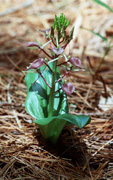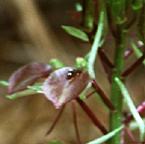Liparis lilifolia (L.) Rich.
Lily-leaved twayblade, large twayblade, mauve sleekwort
The specific epithet lilifolia is the Latin for "lily-leaf",
in reference to the apparent similarity of the leaves to those of lilies.


DESCRIPTION: Plant
glabrous, 10-25 cm tall, arising from an cluster of slender roots; base
of the stem swollen to form a pseudobulb. Leaves 2 (1 in sterile
plants), essentially basal, elliptical to ovate-elliptical, 4-15 cm long
and 2-7 cm wide. Midrib prominent, forming a keel below, leaves smooth and
fleshy. Inflorescence a loose to dense, elongate raceme of madder-purple
flowers, spicate, 4-25 flowered; each flower subtended by a minute lanceolate
bract. Sepals linear-lanceolate, 8-11 mm long and 1-2 mm wide, yellowish-green
to light green, the margins revolute. Petals linear, filiform, 8-12
mm long and about 0.3 mm wide, madder-purple; reflexed. Labellum
obovate to oblong, minutely apiculate at apex, 8-13 mm long and 6-10 mm
wide, colored as petals; central portion of the labellum typically thickened
and darker in color, remainder of the labellum translucent.
SIMILAR SPECIES: Liparis lilifolia would most likely be confused
with L. loeselii In flower, the two can
be distinguished by the color of the flowers, which are only rarely green
in L. lilifolia, but always green in L.
loeselii. Green-flowered specimens L. lilifolia can be separated
from L. loeselii by their relatively
long pedicels (typically greater than 10 mm) and wider labellum and leaves.
Fruiting plants of the two species can also be separated by pedicel length.
HABITAT: Liparis lilifolia is typically found in rich, mesic
woods but also is frequently found in pine plantations. It is rarely found
in dry soils. L. lilifolia seems to be a plant of early successional
habitats, and it frequently undergoes population explosions in such habitats.
Curtis (????) records one such population explosion in the pine planting
at the University of Wisconsin Arboretum. He reports that the plants declined
in abundance after several years. L. lilifolia can still be found
in the pines at the Arboretum, but are very uncommon.
FLOWERING DATES: June 15-July 5.
POLLINATION: My observations indicate that plants rarely develop seed;
apparently they require insects for pollination. Unfortunately, the pollinator(s)
is unknown. The color and shape of the flowers suggest myophily, or fly
pollination. Robertson (1928) observed
a fly visiting L. lilifolia, but it did not effect pollination.
WI DISTRIBUTION:  U.S. DISTRIBUTION:
U.S. DISTRIBUTION:
Go directly to Wisconsin herbarium records.
Return
to the main LIST of the Orchids of Wisconsin.
Return to the main KEY to the Orchids of
Wisconsin.


 U.S. DISTRIBUTION:
U.S. DISTRIBUTION: